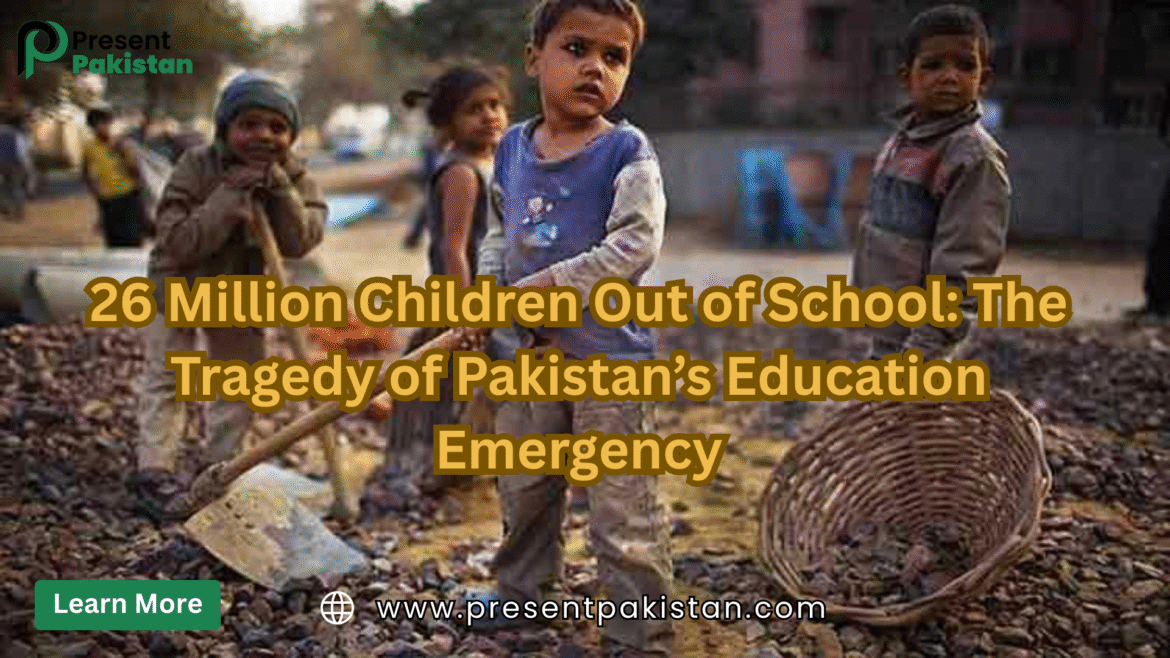A Country in Distress
Education has often been referred to as the backbone of a country. In Pakistan, however, the backbone is broken. In 2025, Pakistan will face one of the largest education crises anywhere in the world as it has in excess of 26 million children out of school, a number that signifies not only lost opportunities for each child, but also a setback for the growth, development, and stability of the nation.
Pakistan’s education emergency has reached a point now where immediate action is no longer a luxury, it is a matter of survival.
Table of Contents
- Powerful Numbers: 26 Million Children Out of School
- The Root Causes of Pakistan’s Education Emergency
- The Root Causes of Pakistan’s Education Emergency
- Government Efforts and Their Shortcomings
- International Response and Support
- Case Study: Punjab’s World Bank Education Project
- Education Emergency: What Needs to Be Done?
- Voices from the Ground: Stories of Out-of-School Children
- The Road Ahead: Can Pakistan Overcome This Tragedy?
- Conclusion
- Support Education for Pakistan’s Future
Powerful Numbers: 26 Million Children Out of School
Reportedly, an astonishing number of more than one-third of school age children in Pakistan are not enrolled in any form of education. This trend is especially prevalent in rural areas, with girls accounting for 55% of those children not receiving an education.
UNICEF and Save the Children have continued to report that enrollment in education in Pakistan is one of the lowest in the world, for a country that is the 5th largest in population.

The Root Causes of Pakistan’s Education Emergency
a) Poverty and Economic Instability
As a result of poverty and economic instability, many families cannot afford to send their children to school, as that may mean losing any additional income a child could earn through child labor. Child labor is so common that it is now seen as a household decision-making process, where families prioritize basic existence over education.
b) Gender Inequities
Because of cultural norms and the fact that many schools are simply not safe for girls, the education emergency in Pakistan disproportionately impacts girls. Many parents pull their daughters from school after the primary cycle or no longer send them along to school at all due to cultural pressure or a lack of adequate separate facilities.
c) The Urban-Rural Divide
Largely, schools in urban centers are better than those in rural areas, and there is often little to no basic infrastructure in rural community schools. In some villages located in more isolated regions, kids could potentially walk for an hour to two hours to get to school, sometimes only to find out that the teacher did not come.
d) Poor Policy Implementation
While Pakistan has already passed legislation at the Federal level to make education “compulsory,” implementation of the law is poorly done. Government budgets allocated for education are around 2% of GDP, one of the lowest among all the countries in the region of South Asia.
Consequences of the Education Crisis on Society
Economic Growth: Pakistan is missing out on billions annually in potential GDP due to the lack of education, without education the economy will miss out.
Child Labor: Factories, brick kilns, and domestic work have millions of school-age children.
Inequality: Wealthy families have access to private schooling while poor communities continue in illiteracy.
Generational Gap: Uneducated generations leads to unemployment, extremism, and instability.

Obligation to Government Support, Capacity, Accountability
Though Pakistan has made an education emergency declaration (2025), little of the prior educational pledge has been achieved: teachers are absent, and corruption siphons resources from education budgets.
International Implementation, Funding, Capacity
International support agencies (World Bank, UNESCO, UNICEF, Save the Children) have been breaking down structures, billions of dollars of assistance typically do not solve inefficiencies.
Education case in point: World Bank Punjab Education Project
In 2025, the World Bank approved a project supporting 4 million school children in Punjab. The World Bank project is to provide inclusive education, digital classrooms and teacher training to children in Punjab. This is a project that is a pilot for the potential for national scale-up in the future.
Education Crisis: What Must Be Done?
Increase Budget Allocation: Increase 2% to at least 5% of GDP spent on education.
Teacher training: invest in skilled teachers, instead of ghost hires.
Technology in learning: implement AI-powered learning and digital learning to close gender gaps.
Public-Private Partnerships: Leverage NGOs and EdTech startups as well as the private sector to solve the crisis.

Voices from the Ground: Experiences of Out-of-School Children
Usually, such testimonials provide nearly equivalent value to steady statistics, an abbreviated raised encountered Ali, report from other classmates, or Saira, 12 years old, who completed her primary schooling yet is still missing an education.
The Way Forward: Can We Move Past This Tragedy?
This educational catastrophe in Pakistan can be addressed; with the right political will, resourcing, and fresh ideas, we can redirect the course of this tragedy.
Education is not only a right.- it is the foundation of peace and growth and development!
If you want a better Pakistan with the right to an education for ALL, then join the movement!
PresentPakistan.com has a number of ways for you to get involved in our advocacy campaigns and the movement as a whole. Together we can re-imagine education in Pakistan.
Conclusion
Pakistan’s 26 million children who are out of school is not just a number; it is a battle deferred, a future lost, and potential wasted. If we do not act now, we risk falling further behind in the race for development globally. We must ACT NOW.
FAQs
How many children are not in school in Pakistan in 2025?
In 2025, the estimated number of out-of-school children in Pakistan is over 26 million out-of-school children in the world.
Why are so many children not in school in Pakistan?
The reasons for the out-of-school statistic include poverty, gender inequality, poor infrastructure, and weak implementation of policy.
What is Pakistan’s education budget?
Pakistan is spending only 2% of its GDP on education, far below the recommended spending from UNESCO of 4-6% state spending to education.
What role can technology play in reforming education?
AI-based learning, digital classrooms, and e-learning can help provide affordable and scalable solutions to education.
How do I help improve education in Pakistan?
People can help improve education in Pakistan by supporting NGOs, volunteering, donating, and raising awareness at different platforms such as PresentPakistan.com.
People Also Ask
What is the most significant challenge facing Pakistan’s education system?
Access and quality are the most significant challenges. Many of them do not have teachers and lack adequate infrastructure and learning materials. Corruption in some areas and low allocations for education (2% of GDP) have made it extremely difficult to provide consistent, quality education. Gender and rural/urban divides exacerbate this gap even further.
2. What is the impact of poverty on children’s education in Pakistan?
Poverty necessitates families needing to choose survival in the immediate term, rather than to provide an education for their children. Many of the children that you would have enrolled in school are now working in workplaces or helping in the home of a family. Very poor families cannot pay school fees or afford uniforms and transportation. Boys are frequently able to obtain an education or attend school because parents often view the value of education as greater than for daughters due to their ability to work and contribute to the family.
3. What are the recommendations for fixing Pakistan’s education crisis?
Increase education expenditure at minimum to 5% of GDP.
Train and support teachers to increase accountability and address the issues of “ghost” teachers.
Increase digital and AI-powered learning to support areas that are not easily reached.
Encourage boys and girls education through quality infrastructure and separate safe facilities for girls to attend school.
Create sustainable public-private partnerships for school building and educational scholarships for extremely poor families.







